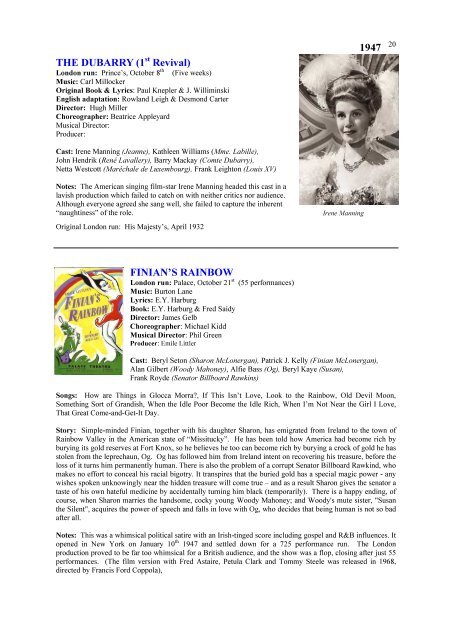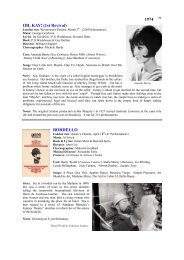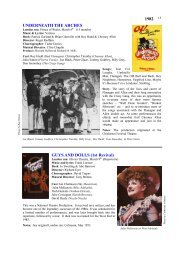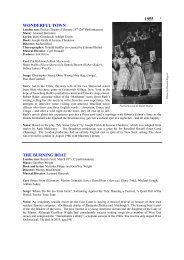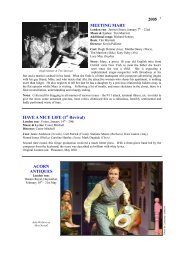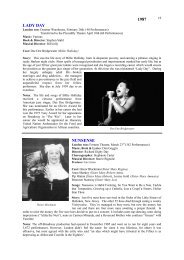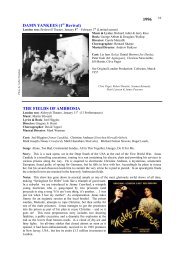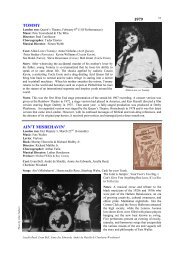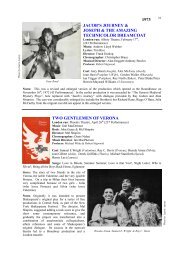London Musicals 1945-1949.pub - Over The Footlights
London Musicals 1945-1949.pub - Over The Footlights
London Musicals 1945-1949.pub - Over The Footlights
Create successful ePaper yourself
Turn your PDF publications into a flip-book with our unique Google optimized e-Paper software.
THE DUBARRY (1 st Revival)<br />
<strong>London</strong> run: Prince’s, October 8 th (Five weeks)<br />
Music: Carl Millocker<br />
Original Book & Lyrics: Paul Knepler & J. Williminski<br />
English adaptation: Rowland Leigh & Desmond Carter<br />
Director: Hugh Miller<br />
Choreographer: Beatrice Appleyard<br />
Musical Director:<br />
Producer:<br />
Cast: Irene Manning (Jeanne), Kathleen Williams (Mme. Labille),<br />
John Hendrik (René Lavallery), Barry Mackay (Comte Dubarry),<br />
Netta Westcott (Maréchale de Luxembourg), Frank Leighton (Louis XV)<br />
Notes: <strong>The</strong> American singing film-star Irene Manning headed this cast in a<br />
lavish production which failed to catch on with neither critics nor audience.<br />
Although everyone agreed she sang well, she failed to capture the inherent<br />
“naughtiness” of the role.<br />
Original <strong>London</strong> run: His Majesty’s, April 1932<br />
Irene Manning<br />
1947<br />
20<br />
FINIAN’S RAINBOW<br />
<strong>London</strong> run: Palace, October 21 st (55 performances)<br />
Music: Burton Lane<br />
Lyrics: E.Y. Harburg<br />
Book: E.Y. Harburg & Fred Saidy<br />
Director: James Gelb<br />
Choreographer: Michael Kidd<br />
Musical Director: Phil Green<br />
Producer: Emile Littler<br />
Cast: Beryl Seton (Sharon McLonergan), Patrick J. Kelly (Finian McLonergan),<br />
Alan Gilbert (Woody Mahoney), Alfie Bass (Og), Beryl Kaye (Susan),<br />
Frank Royde (Senator Billboard Rawkins)<br />
Songs: How are Things in Glocca Morra?, If This Isn’t Love, Look to the Rainbow, Old Devil Moon,<br />
Something Sort of Grandish, When the Idle Poor Become the Idle Rich, When I’m Not Near the Girl I Love,<br />
That Great Come-and-Get-It Day.<br />
Story: Simple-minded Finian, together with his daughter Sharon, has emigrated from Ireland to the town of<br />
Rainbow Valley in the American state of “Missitucky”. He has been told how America had become rich by<br />
burying its gold reserves at Fort Knox, so he believes he too can become rich by burying a crock of gold he has<br />
stolen from the leprechaun, Og. Og has followed him from Ireland intent on recovering his treasure, before the<br />
loss of it turns him permanently human. <strong>The</strong>re is also the problem of a corrupt Senator Billboard Rawkind, who<br />
makes no effort to conceal his racial bigotry. It transpires that the buried gold has a special magic power - any<br />
wishes spoken unknowingly near the hidden treasure will come true – and as a result Sharon gives the senator a<br />
taste of his own hateful medicine by accidentally turning him black (temporarily). <strong>The</strong>re is a happy ending, of<br />
course, when Sharon marries the handsome, cocky young Woody Mahoney; and Woody's mute sister, "Susan<br />
the Silent", acquires the power of speech and falls in love with Og, who decides that being human is not so bad<br />
after all.<br />
Notes: This was a whimsical political satire with an Irish-tinged score including gospel and R&B influences. It<br />
opened in New York on January 10 th 1947 and settled down for a 725 performance run. <strong>The</strong> <strong>London</strong><br />
production proved to be far too whimsical for a British audience, and the show was a flop, closing after just 55<br />
performances. (<strong>The</strong> film version with Fred Astaire, Petula Clark and Tommy Steele was released in 1968,<br />
directed by Francis Ford Coppola),


